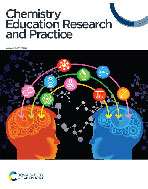Resources for reasoning of chemistry concepts: multimodal molecular geometry†
Abstract
Central to conceptual understanding of STEM disciplines is visuospatial processing. Despite its acknowledged role in assuring learners’ success, less is known about the underlying reasoning students must employ when solving 3-D problems and the ways in which gaining an understanding of this can inform formative assessment and learning in STEM education. Chemists must utilise their spatial understanding when visualising 3-D structures and processes from 2-D representations and so this exploratory practitioner-researcher study sought to identify the ways in which secondary school chemistry students reason when explaining their predictions about molecular geometry, and how the use of certain modalities was linked to assessed accuracy. Coding of students’ verbal and written responses to the research task revealed that students employed multiple reasoning strategies and conceptual resources to facilitate use of analytical heuristics and imagistic reasoning. Analysis of students’ verbal responses and spontaneous gestures provided insight into the extent of imagistic vs. analytical reasoning and the finer-grained conditions which promoted their use. Importantly, it was observed that despite being instructed on the use of VSEPR theory to find analytical solutions, some students exhibited preference for alternative reasoning strategies drawing upon imagistic reasoning; showing more nuanced and varying degrees of accuracy through their verbal responses and representations gestured in 3D space. This work has pedagogical implications as use of specific reasoning strategies and the identification of key conceptual resources is not readily promoted as classroom practice for learning or assessment. This study therefore raises questions and contributes to the evidence base for attending to learners’ visuospatial thinking, as revealed through the multiple modalities they may use to assist and communicate their understanding, and highlights the significance of this to formative assessment in Chemistry and STEM Education.


 Please wait while we load your content...
Please wait while we load your content...